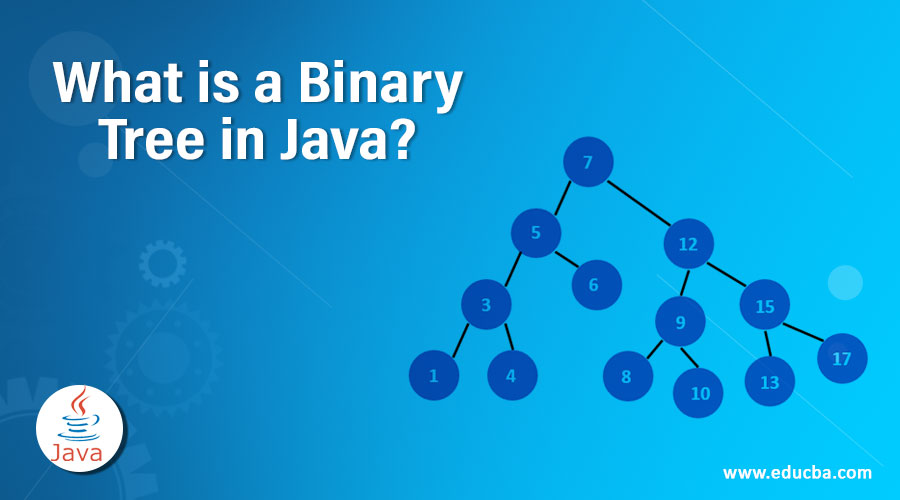Updated June 9, 2023

Introduction to Binary Trees in Java
A binary Tree in Java is a renowned type of data structure where data or objects are arranged in a non-linear hierarchical structure, and every item is called a ‘node’ while all the nodes are connected to the root node starting point. The placement of the data or objects is made so that the value of every left-side node is low or equal to the root node, and the value of every right-side node is high or equal to the root node. Any given binary tree should have at least one root node, and the parent nodes can have a maximum of two child nodes in every level of the hierarchical tree.
Understanding Binary Tree in Java
BST(Binary Search Tree) is a well-known data structure that is required to retain parts in sequence. Every binary search tree is a binary tree in which the valuation of a left-side child node is lower or equivalent to the parent node, and the valuation of the right child is larger than or equivalent to the parent node.
How does Binary Tree in Java make working so easy?
Binary Tree in Java makes working so easy as they are utilized to execute binary search trees and binary heaps, attaining applications in sorting algorithms and effective searching.
What can you do with Binary Tree in Java?
With the Binary tree in Java with the children, nodes are parent nodes and might hold mentions to their parent nodes. From the exterior of the binary tree, there is usually a root node reference as every node’s ancestor in case it is in existence. Every node is the information structure that could be approached by beginning at the root’s node and recurringly ensuing references to rather to the left child or right child. The binary tree cannot have any node, or it might consist of a root node specified as a null tree. The maximum parent nodes can have about two child nodes in each binary tree.
Advantages
Considering it is a binary tree, it could have zero child node, one child node, or two children. The binary search tree specialty is its capability to lessen the time complication of basic processes such as remove, search and add, including identified as to find, insert, and delete. Every operation, such as remove, find, and insert, can be carried out by a binary search tree on time. The basis for the enhancements in speed is due to the unique attribute of the binary search tree for every node, the information in the left side child is lower than or equivalent, and the information in the right child is more than or equivalent to the information in the said node.
Why should we use Binary Tree in Java?
The structure of tree data is beneficial in moments when a linear representation of information is not enough, just like building a family tree. There are two inbuilt categories in Java: TreeMap and TreeSet, under Java Framework Collection, that serve the programmer’s requirements to specify data components in the above-mentioned form.
Scope
As previously mentioned, the Java framework collection consists of two variations of tree executions; one of them is TreeSet, and the other is TreeMap. The fascinating characteristics of the above-mentioned three categories are that one is equipped as a Set and another as a Map. The interfaces of Map and Set were executed through abstract categories such as AbstractMap and AbstractSet.
How does a binary tree work?
The attributes it enforces at the time of the compilation of the components are established on the abstraction model’s analytical set. The attribute of Map enforces the compilation of components should have a key valuation pair. Every key outline to just 1 value which implies it rejects duplicate keys. Each value has a different key that can be replicated. TreeSet and TreeMap are the two categories of binary trees that comply with the particular standards obtained from their particular interfaces aside from organizing its data structure internally in a binary tree pattern.
Why do we need a Binary Tree in Java?
The binary tree, with its many categories, is unique because it is easy and effective to execute. The binary trees’ limitations are that they enable at least two nodes children under a parent node as they are known as right side child or left side child accordingly. The binary tree advancing from the right side child is known as the right subtree, and advancing from the left side child is known as a left sub tree. This is usually for every binary tree due to a binary tree with several execution schemes. These schemes have distinct established standards for building and maintenance, which immediately affects access to data components norms generally estimated in the notion of Big O.
Career Growth
Software and SaaS solutions can be created by implementing Binary Tree to facilitate the enterprises in every location to modify and lead to future technology. The programmers can advance their careers by learning this binary tree and exploring the scope to create more utilization.
Conclusion
The TreeMap and TreeSet are usually the clearest execution of binary tree data structures in the library of JavaAPI. As the data laws, the structure does not obtain any distinction in its utilization for high-grade users. However, the tree structure is somewhat more complex and ineffective than linear or non-tree counterparts, such as HashMap and HashSet, because of its several rules to preserve a balanced tree structure’s standards.
Recommended Articles
This has been a guide to What is a binary tree in Java. Here we discuss the Advantages, Scope, and career growth of a binary tree in java. You may also look at the following articles to learn more –


